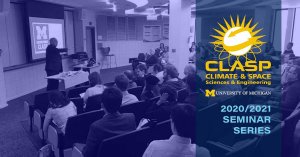Presented By: Climate and Space Sciences and Engineering
U-M Climate & Space Seminar Series:
Dr. Shannon Brown, NASA Jet Propulsion Laboratory

Named the U-M Climate & Space Alumni of the Year, Dr. Shannon Brown, principal technologist and the supervisor of the microwave instrument science group at NASA's Jet Propulsion Laboratory, will give a seminar on Thursday, Nov. 17. A reception will follow the seminar, which is part of the U-M Climate & Space Seminar Series.
Please join us! The talk will also be streamed live and recorded via Zoom. For details, visit the CLASP Seminar Series webpage.
Abstract:
Instrument science bridges the fields of science and engineering and it’s where I’ve found myself since graduating from Michigan nearly two decades ago. The art is translating the discoveries scientists want to make into the instruments engineers can build (and launch into space). This talk will reminisce on my nearly two decades of research and instrument development of passive microwave radiometer systems at the Jet Propulsion Laboratory.
Getting from the tiniest nugget of an idea to a full-fledged science mission in space requires persistence, agile thinking and a bit of luck. Space-based missions generally follow a familiar pattern; the initial honeymoon period where anything is possible, building hardware where nothing seems possible and finally science operations where no one expected what was possible. Each of these phases is unique, immensely interesting and the instrument scientist is one of only a few project jobs that spans all three. I’ll share a mix of stories and science from inside the development of the NASA Juno mission and the US Space Force Compact Ocean Wind Vector Radiometer (COWVR) mission. Both of these missions had unique challenges. COWVR was a 2-year instrument development that took 10-years to get into space, finally landing on the International Space Station in 2022. Juno had to be designed to survive the harsh Jovian environment. But once they reached their destination in space, they have been changing our understanding of Jupiter and its moons and demonstrating revolutionary technology back here on Earth. Getting there is never easy nor follows a linear predictable path, but that is what makes it so
interesting.
Shannon T. Brown is a principle technologist and supervisor of microwave instrument science group at the NASA Jet Propulsion Laboratory in Pasadena, CA. He received a B.S degree in Meteorology from the Pennsylvania State University and a M.S. in Atmospheric Science from the University of Michigan. He received a Ph.D. in Geoscience and Remote Sensing in 2005, also from the University of Michigan under the advisement of Professor Christopher Ruf. His research interests include microwave radiometer instrument design, calibration and algorithm development for spaceborne and airborne instruments. He has been involved with the spaceborne Topex and Jason Microwave Radiometers, WindSat Polarimetric Radiometer and the Jason follow-on Advanced Microwave Radiometers on Jason-2/3, Sentinel-6 and SWOT along with a number of airborne radiometers. He is the instrument scientist for the NASA Juno Microwave Radiometer and principal investigator for the US Space Force Compact Ocean Wind Vector Radiometer instrument that is deployed on the International Space Station.
Please join us! The talk will also be streamed live and recorded via Zoom. For details, visit the CLASP Seminar Series webpage.
Abstract:
Instrument science bridges the fields of science and engineering and it’s where I’ve found myself since graduating from Michigan nearly two decades ago. The art is translating the discoveries scientists want to make into the instruments engineers can build (and launch into space). This talk will reminisce on my nearly two decades of research and instrument development of passive microwave radiometer systems at the Jet Propulsion Laboratory.
Getting from the tiniest nugget of an idea to a full-fledged science mission in space requires persistence, agile thinking and a bit of luck. Space-based missions generally follow a familiar pattern; the initial honeymoon period where anything is possible, building hardware where nothing seems possible and finally science operations where no one expected what was possible. Each of these phases is unique, immensely interesting and the instrument scientist is one of only a few project jobs that spans all three. I’ll share a mix of stories and science from inside the development of the NASA Juno mission and the US Space Force Compact Ocean Wind Vector Radiometer (COWVR) mission. Both of these missions had unique challenges. COWVR was a 2-year instrument development that took 10-years to get into space, finally landing on the International Space Station in 2022. Juno had to be designed to survive the harsh Jovian environment. But once they reached their destination in space, they have been changing our understanding of Jupiter and its moons and demonstrating revolutionary technology back here on Earth. Getting there is never easy nor follows a linear predictable path, but that is what makes it so
interesting.
Shannon T. Brown is a principle technologist and supervisor of microwave instrument science group at the NASA Jet Propulsion Laboratory in Pasadena, CA. He received a B.S degree in Meteorology from the Pennsylvania State University and a M.S. in Atmospheric Science from the University of Michigan. He received a Ph.D. in Geoscience and Remote Sensing in 2005, also from the University of Michigan under the advisement of Professor Christopher Ruf. His research interests include microwave radiometer instrument design, calibration and algorithm development for spaceborne and airborne instruments. He has been involved with the spaceborne Topex and Jason Microwave Radiometers, WindSat Polarimetric Radiometer and the Jason follow-on Advanced Microwave Radiometers on Jason-2/3, Sentinel-6 and SWOT along with a number of airborne radiometers. He is the instrument scientist for the NASA Juno Microwave Radiometer and principal investigator for the US Space Force Compact Ocean Wind Vector Radiometer instrument that is deployed on the International Space Station.